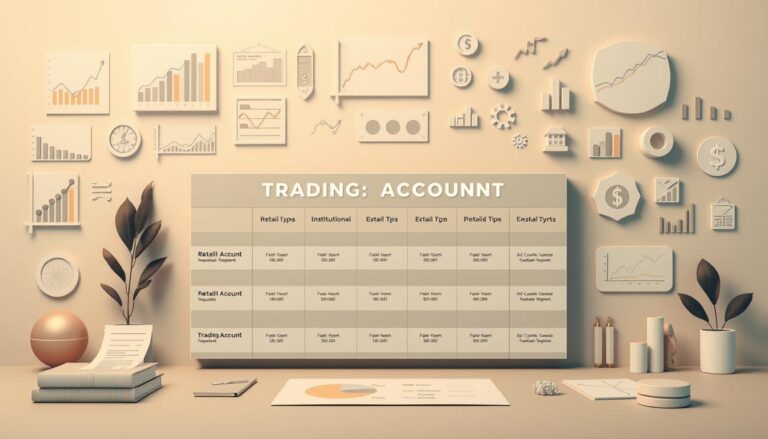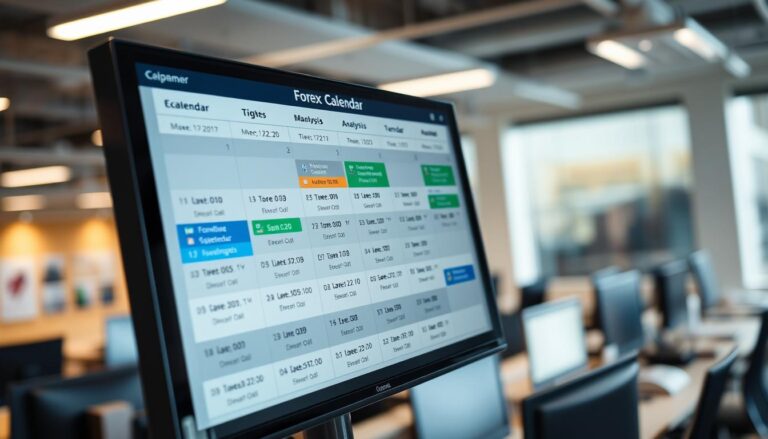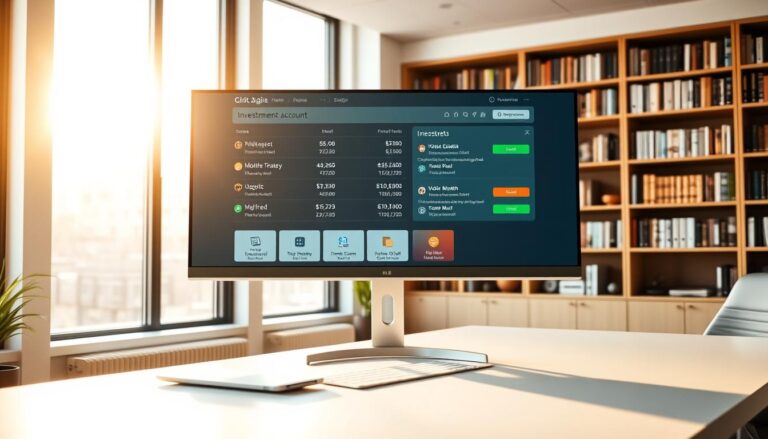What Is a Raw Spread Account in Forex and Who Should Use It?
Forex traders seeking transparent pricing often explore specialized account types. One popular option is the raw spread account, which separates trading costs into two parts: the spread and a fixed commission. This structure differs from standard accounts, where brokers bundle fees into wider spreads.
With these accounts, spreads can start as low as 0.0 pips. Brokers like TIOmarkets charge $6 per lot in commissions alongside these tight spreads. For comparison, their standard accounts show 1.1-pip spreads with no extra fees. This model benefits frequent traders who prioritize predictable costs over simplicity.
Major platforms such as IC Markets and Pepperstone also offer similar setups. Each firm structures commissions differently, so traders should compare terms carefully. Active users often find the combined spread-and-commission approach cheaper overall, especially when placing numerous trades.
Who benefits most from this setup? High-volume traders and scalpers typically gain the most value. The lower spreads help capture small price movements, while fixed commissions make cost calculations straightforward. Casual traders might prefer standard accounts for simpler fee management.
Choosing between account types depends on strategy and trade frequency. Those executing dozens of weekly trades could save significantly with raw pricing models. Always verify a broker’s execution quality alongside costs, as slippage can offset tight spread advantages.
Understanding Forex Trading Account Types
Currency markets attract participants with diverse strategies, creating demand for tailored trading solutions. Brokers address this by offering multiple account types, each designed for specific skill levels and objectives. These options directly influence costs, execution quality, and available tools.
Overview of Trading Platforms’ Offerings
Three primary models dominate forex trading environments. Fixed pricing models bundle fees into wider bid-ask differences, ideal for newcomers seeking simplicity. Commission-based alternatives split costs between tighter spreads and per-trade fees. Direct-access setups mirror interbank rates but require technical expertise.
Why Selection Impacts Success
Active traders executing 20+ weekly positions often benefit from lower overall costs in commission structures. Beginners might prefer straightforward pricing despite higher per-trade expenses. The right choice balances cost efficiency with personal trading habits and market knowledge.
Execution speed varies between account types. Some models prioritize rapid order filling, while others focus on cost predictability. Always verify a broker’s execution statistics alongside advertised pricing terms.
What is a Raw Spread Account in Forex?
Transparent fee structures have become a priority for experienced forex participants. A raw spread account delivers this by separating trading costs into two clear components: ultra-tight pricing from liquidity providers and a fixed fee per transaction. Brokers like TIOmarkets showcase spreads as low as 0.0 pips alongside a $6 commission per traded lot, while IC Markets charges $3.50 per $100k traded.
This model connects traders directly to interbank rates without broker markups. Three features define its appeal:
- Real-time pricing: Eliminates artificial spread widening during volatile markets
- Cost predictability: Commissions remain fixed regardless of trade size or currency pair
- Speed advantages: Orders often execute faster due to streamlined liquidity access
High-frequency strategies particularly benefit from these conditions. Scalpers capturing fractional price movements gain more profit potential when spreads start at zero. Meanwhile, position traders appreciate knowing exact commission costs upfront for precise risk calculations.
While ideal for active users, these setups require monitoring both spread and commission impacts. A 0.2-pip EUR/USD spread with a $5 fee might prove cheaper than a 1.5-pip standard account spread for frequent trades. Always compare total costs across brokers before committing.
Standard vs Raw Spread Account: Key Differences
Fee models significantly influence trading outcomes, making account selection crucial for profitability. Two primary structures dominate forex: bundled pricing and split-cost frameworks. Understanding their mechanics helps traders align choices with strategy and volume.
Cost Structure Analysis
Standard pricing combines all fees into wider bid-ask differences. For example, TIOmarkets offers 1.1-pip spreads on EUR/USD with no additional charges. This simplicity appeals to casual traders who value predictable expenses.
Commission-based alternatives separate costs. The same broker charges 0.0 pips plus $6 per lot, resulting in 55% lower fees per trade. High-frequency traders benefit from this model, as reduced overall costs compound across multiple positions.
Spread versus Commission Models
Bundled spreads typically range from 1.0 to 3.0 pips, varying by currency pair. This approach requires no extra calculations, ideal for those executing fewer monthly trades.
Split-fee systems start near interbank rates but add $3-$7 commissions. While slightly more complex, they provide clearer insight into true execution costs. Active users often prefer this transparency, especially when scalping or arbitraging small price movements.
Brokers like IC Markets demonstrate how these models diverge. Their standard EUR/USD spread sits at 1.0 pips, while their commission-based alternative offers 0.1 pips plus $3.50 per lot. Frequent traders save $7.50 per $100k traded compared to bundled pricing.
Detailed Transaction Fee Breakdown
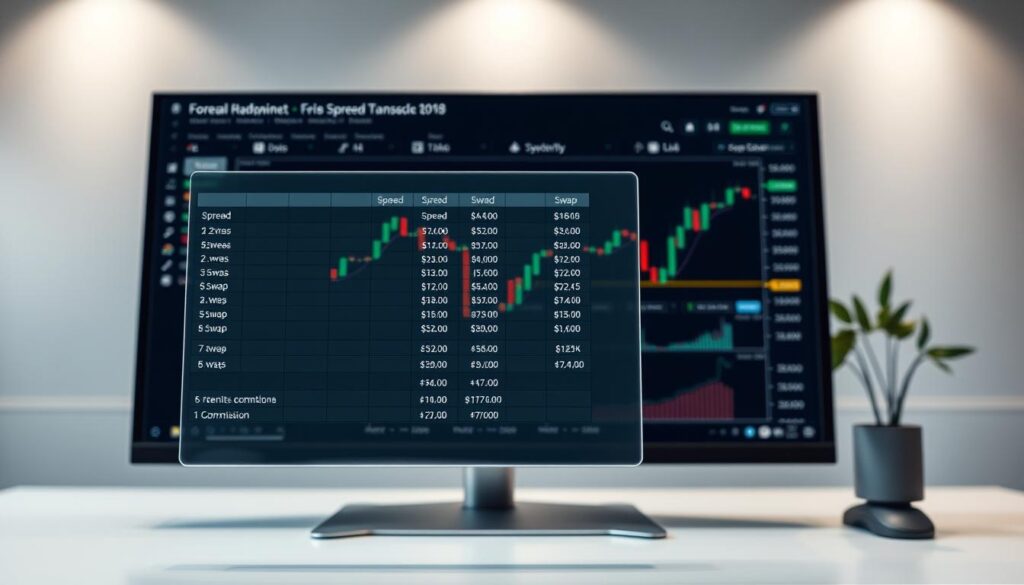
Understanding trading fees requires dissecting two primary components: variable pricing differences and fixed charges. This clarity helps traders forecast expenses accurately and compare broker offerings effectively.
Calculating Spread Costs and Commissions
Currency pairs with USD as the quote currency simplify math: each pip equals $10 per standard lot. A 1.1-pip difference translates to $11 per traded lot. Commission-based models add separate fees, like TIOmarkets’ $6 charge alongside near-zero pricing differences.
Three factors influence total costs:
- Trade size: Larger positions amplify both spread and commission impacts
- Broker policies: Some firms apply fees per transaction side, others per completed trade
- Currency pair volatility: Wider pricing gaps during news events increase spread costs
Real-World Fee Examples
TIOmarkets demonstrates cost differences clearly. Their standard model charges $11 per lot on EUR/USD, while their alternative model costs $6 ($0 spread + $6 commission). Active traders executing 100 lots monthly save $500 with the second option.
Other brokers show similar patterns. Pepperstone charges $7 per standard lot alongside 0.0-pip pricing for major pairs. IC Markets combines 0.1-pip differences with $3.50 fees, creating lower costs for high-volume strategies.
Always verify whether commissions apply per million units or standard lot. This distinction determines whether fees scale linearly with position size or remain fixed across trade volumes.
Comparing Execution Fees for Brokers
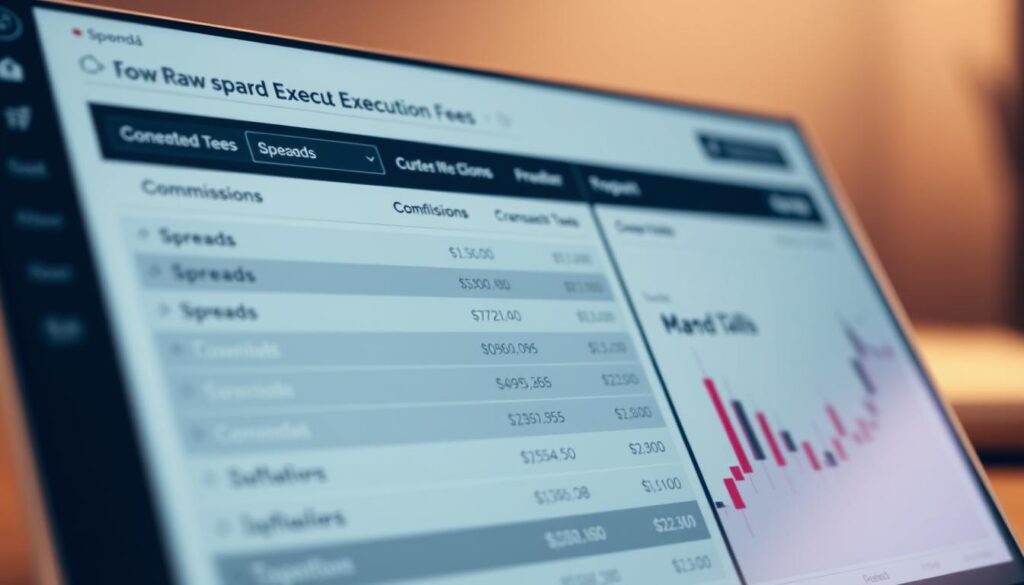
Fee structures separate top brokers in competitive forex markets. While all commission-based models promise tight pricing, actual costs vary widely between providers. Traders must scrutinize both advertised rates and hidden factors affecting net expenses.
TIOmarkets Versus Other Broker Models
TIOmarkets charges $6 per standard lot alongside 0.0-pip starting spreads. This positions them mid-range among competitors like IC Markets, which offers $3.50 per $100k traded. Pepperstone and FP Markets mirror this approach with 0-pip bases plus $7 and $4 fees respectively.
Four critical factors differentiate these brokers:
- Commission scaling: Some charge per lot, others per million units traded
- Minimum deposits: Ranging from $250 at TIOmarkets to $0 at Fusion Markets
- Currency pair coverage: Major pairs often have better rates than exotics
- Volume discounts: Reduced fees for high-frequency traders
Execution quality often determines real costs more than advertised rates. Brokers with superior liquidity networks like IC Markets maintain tighter spreads during volatile sessions. Meanwhile, platforms with slower order processing may incur slippage, eroding potential savings from low commissions.
Scalpers typically favor brokers with the lowest per-trade fees, while position traders prioritize execution reliability. Always test platforms through demo accounts before committing funds.
Leverage and Margin Considerations

Strategic position sizing separates disciplined traders from reckless gamblers in currency markets. Leverage ratios determine how much trading capital gets amplified, directly influencing profit potential and risk exposure.
Understanding Leverage Ratios
Brokers like TIOmarkets showcase how account types differ. Their standard setups permit unlimited leverage, while specialized versions cap ratios at 1:500. This means controlling $100,000 positions with just $200 margin.
Three factors shape leverage decisions:
- Regulatory limits: EU brokers restrict retail clients to 1:30
- Market volatility: High leverage during news events increases risk
- Position sizing: Larger trades require careful margin management
Impact on Trading Capital
While 1:500 leverage frees up money for additional orders, it multiplies potential losses. A 2% price move against a fully leveraged position wipes out 100% of capital.
Professional traders often use 1:10 to 1:50 ratios. This balances opportunity with protection against sudden market shifts. Margin calls become less frequent when maintaining 50%+ free margin across positions.
Choosing appropriate leverage requires testing strategies under various conditions. Demo accounts help identify sustainable ratios before risking real funds.
Trading Platforms and Market Access Insights
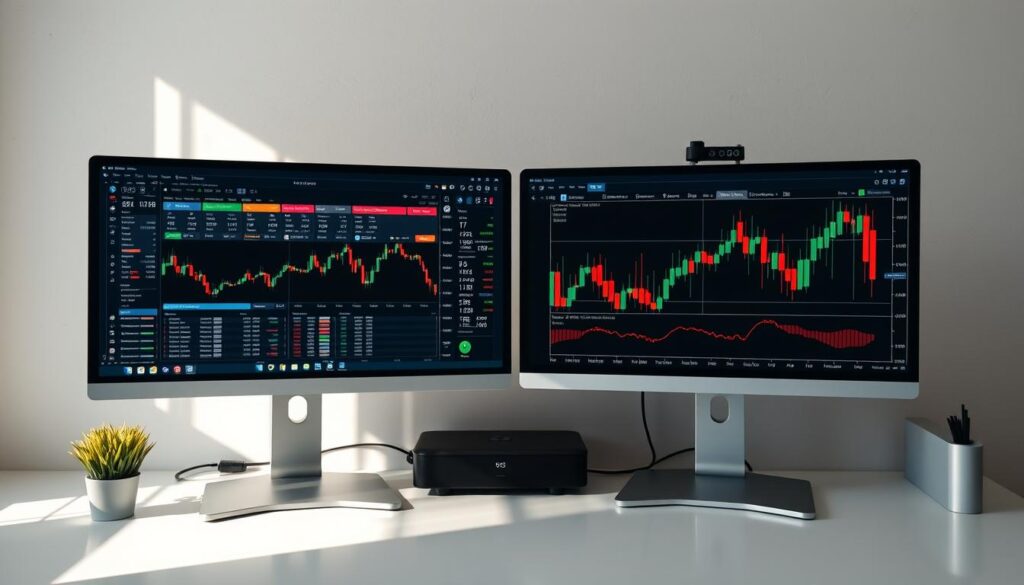
Platform selection shapes trading efficiency across global currency markets. Three dominant systems—MetaTrader 4, MetaTrader 5, and cTrader—power most transactions. Each offers unique tools that align with different strategies and skill levels.
MT4, MT5, and cTrader Platform Comparisons
MetaTrader 4 remains the go-to choice for forex specialists. Its intuitive design supports manual trades and automated systems through expert advisors. Brokers like IC Markets and Pepperstone integrate MT4 seamlessly with their services, ensuring reliable order execution.
MetaTrader 5 expands capabilities with 21 timeframes and hedging options. Traders accessing stocks or commodities alongside currencies often prefer this platform. Its advanced backtesting features help optimize strategies before live deployment.
cTrader shines with Level II market depth displays and precision order controls. These features prove invaluable for scalpers exploiting micro price movements. Platforms maintain fee consistency across account types, letting users focus on technical advantages rather than cost changes.
Execution speeds vary between systems. MT4 processes simple orders fastest, while cTrader handles complex trade management more efficiently. Most brokers offer all three platforms, enabling traders to switch based on evolving needs without changing accounts.
Funding Options and Minimum Deposit Requirements
Accessing premium trading conditions often requires meeting specific capital thresholds. Brokers like TIOmarkets set a $250 minimum deposit for their advanced pricing models, compared to $20 for basic setups. This gap reflects the target audience: frequent traders who need sufficient capital to benefit from lower per-trade fees.
Multiple base currencies simplify international participation. Requirements vary:
- $250 for USD, EUR, and GBP
- $375 for AUD and CAD
- R6,250 for ZAR
All funding methods work across account types. Debit cards, bank transfers, and e-wallets process deposits instantly. Cryptocurrency options provide additional flexibility without extra fees for minimum amounts.
Higher entry requirements serve two purposes. They ensure traders have enough capital to absorb market fluctuations. They also justify the broker’s infrastructure costs for direct liquidity access. Withdrawals typically require using the original payment method, following standard financial regulations.
Traders should calculate whether potential savings outweigh the initial commitment. Those placing 50+ monthly trades often recover the higher deposit through reduced transaction costs. Casual users might prefer lower barriers to entry with standard accounts.
Advantages and Disadvantages of Raw Spread Account Trading
Market participants evaluating cost-efficient strategies often weigh specialized trading structures. Commission-based models appeal to certain styles while posing challenges for others. Key factors like trade frequency and risk tolerance determine whether these setups align with individual goals.
Benefits for High-Volume Traders
High-volume traders gain significant advantages through reduced per-transaction fees. Platforms like TIOmarkets demonstrate 55% lower costs compared to standard pricing for frequent orders. Tight pricing differences allow precise entry/exit points, crucial for strategies targeting small profit margins.
Scalpers and algorithmic systems benefit most. Fixed commissions simplify expense forecasting across hundreds of monthly trades. These savings compound over time, directly boosting net profitability.
Potential Risks and Drawbacks
Commission models require larger initial capital to offset fixed fees. Market volatility can negate tight pricing benefits if spreads widen unexpectedly. Beginners might struggle with complex cost calculations compared to all-inclusive spreads.
Platforms with slower execution erode potential savings through slippage. Traders should assess whether frequent activity justifies the learning curve and minimum deposit requirements. Those executing fewer than 20 weekly trades often find standard accounts more practical.

